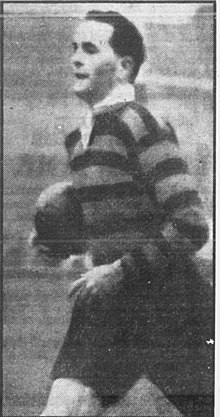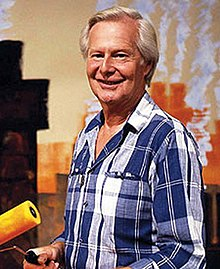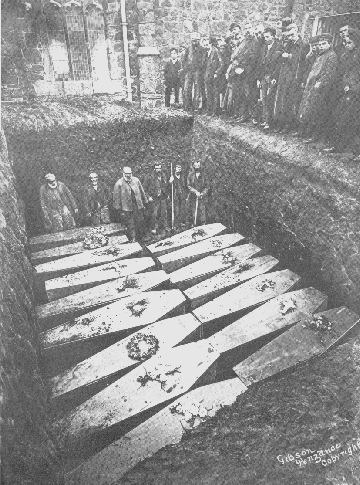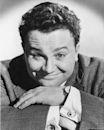Christ Church, Shamley Green
 |
| Shamley Green, Surrey |
Shamely Green, Surrey is a village part of the Surrey Hills Area of Outstanding Natural Beauty. The village is situated between Wonersh and Cranleigh.
The village comprises of a public open space in the village
which has a cricket green. Also, the
village boasts two public houses, the Red Lion and the Bricklayers Arms. During 2013, the village featured on the Horizon
episode The Secret Life of the Cat, the program established the village
had a highest destiny feline within the United Kingdom.
 |
| Christ church, Shamley Green |
The original graveyard surrounding the church became full by
1900. Additional land was given by
George Cubitt, 1st Baron Ashcombe.
It is here that Harry Secombe,
Tony Hart and John Selwyn Moll are buried.
 |
| John Selwyn Moll |
On the eve of the Second World War, Moll, played for the Barbarians. During the conflict he played rugby sevens
for Rosslyn Park.
Whilst studying at Bedford School, Moll, was a member of
Army Cadet Force. Completing school, he joined the Northumberland Hussars
regiment of the Territorial Army.
 |
| Norman Anthony Hart |
Hart was an English artist, best remembered for his work in
educated children through his role as a children’s presenter.
After his finishing his education where he attended both All
Saints Margaret Street Resident Choir School and Clayesmore School, Dorset. 1942, Hart, wanted to join the Royal Air
Force, however, with an eyesight deficient, resulting in not being able to fly,
Hart followed his father’s footsteps, and joined the British Indian Army, where
he gained an officer’s commission in the 1st Gurkha Rifles. Following the Indian Independence of 1947, all
lower-ranked British officers, were being replaced by Indian officers,
resulting Hart returning to civilian life.
At the outbreak of the Korean War, June 1950, Hart was re-commissioned
in the Territorial Army, attached to the Royal Artillery.
Finally, being demobilised, Hart, became a professional artist,
studying at Maidstone College of Art, graduated 1950. Hart became freelance artist.
 |
| Morph |
 |
| Blue Peter badge |
Hart married 1953, Jean Skingle. Jean died 2003. Six years later, January 2009 Hart had died.
In the older section of the churchyard, is the grave of Harold Simmonds, who aged 20 was victim of S.S. Mohegan.
S.S. Mohegan was a stream which sank off the coast of
the Lizard Peninsula, Cornwall, 14th October 1898. This was her second voyage.
 |
| S.S. Mohegan |
Starting out as Cleopatra, she sailed on her maiden voyage on 31st July 1898 from London to New York. Whilst at New York, a number of defects were revealed, the water system feeding the boilers had boilers had malfunctioned and a series of serious water leaks were reported. These problems were blamed on the speed of the construction of the ship. Cleopatra returned to London under half speed. The repairs which took 14 days to carry out. The Board of Trade pronounced the ship fit to sail and duly renamed Mohegan.
 |
| Captain Richard Griffith |
Sailing down the English Channel Mohegan reached her
maximum speed, keeping close to the coast passing Cornwall, she took the
wrong bearing. This was noticed by the
crew and passengers alike, that the coast was to close and Eddystone Lightstone
in the distance. Nearing the entrance of Falmouth Harbour and turned towards
the Helford River and down The Lizard cost slowing down to 13 knots. Mohegan
unaware of the dangers, by rockets fired the Coverack coastguard, maintained her
course heading full speed towards the Manacle Rocks.
The crew were finally alerted to the dangers, the engines
were stopped at 6.50 but it was a little to late. The Mohegan ran aground, embedding the
rudder in the rock and ripping the hull open.
At the time, dinner was being served and many of the 57 passengers were initially
unaware. Below them the engine room flooded in 3 feet
of water. The crew rushed to the deck. The
ship plunged into the darkness and soon the passengers made their way to the
deck, and attempts were made to launch the lifeboats.
There were further problems in encountered when the Mohegan
listed heavily to port and then heavily to starboard. Only two lifeboats launched, one was virtually
swamped and the other capsized. The ship
sank with 12 minutes of hitting the rocks, with a loss of 106 lives.
 |
| Mass grave St. Keverne churchyard |
Also, board was Chief Officer, Llewellyn Couch, whose body
was brought back to Swansea for burial Danygraig Cemetery. He was the brother of Drs James and K. Couch.
We can see from his death certificate that Llewellyn died
due to drowning.
 |
| Llewellyn Couch's death certificate |
 |
| 4th November 1898 The Cambrian |
 |
| 17th October 1898 Evening Express |
There is also the connection with Swansea at Christ church and that is burial of Harry Secombe, which will be another blog.







Comments
Post a Comment